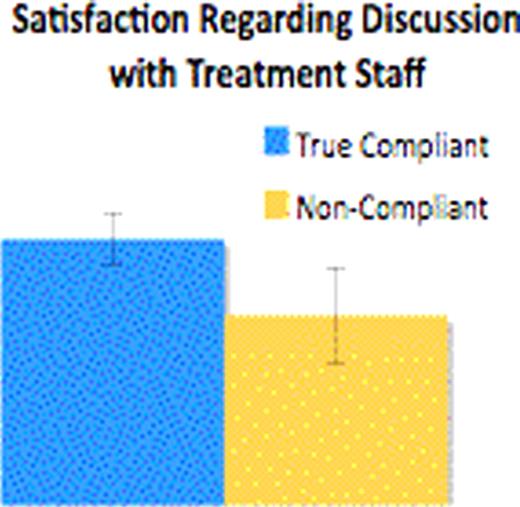Abstract
Abstract 4481
Tyrosine kinase inhibitors (TKIs) targeting the BCR-ABL fusion protein have greatly improved outcome of patients with CML. Despite this, some patients fail to respond or lose their initial response on continued treatment. Reasons for this are not completely understood and may include poor patient compliance. We developed a questionnaire (CML-Q) to explore patient knowledge of CML and its predictive value in compliance and response to treatment. Relationship of compliance with serum drug levels was also studied.
Patients enrolled in the CML program at LAC+USC Medical Center were eligible. CML-Q included 42 questions addressing patient demographics (14%), prior knowledge of CML (7%), specifics about cause and pathogenesis of CML (5%), self-perceived compliance (5%), satisfaction regarding treatment and healthcare providers (19%) and quality of life (50%). Physician assessed patient compliance was determined separately. In patients currently on imatinib, serum drug trough levels were determined using commercially available laboratory testing. T-test and Fisher Exact test were used for statistical analysis with a 0.05 nominal significance level.
The CML-Q was administered to 80 patients. Of these, 39 responded while the rest either declined or were lost to follow up. Amongst the 39 evaluable patients (18 females; 46%, 21 males; 55%) median age was 47.5 yr (range 25–78) and median time since diagnosis was 34.1 mth (range 9–230). Majority of these (n=33; 84.6%) were on TKIs at the time of analysis. Four (11%) patients had received previous stem cell transplant for CML. Amongst the patients 19 (49%) were on first, 7 (18%) on second, 5 (13%) on third, 5 (13%) on fourth, 2 (5%) on fifth and 1 (2%) on seventh line treatment. Twenty-six patients (66%) responded to the Spanish version of CML-Q, while 13 (34%) responded in English. Responses to CML-Q were complete in 49% cases, while others had some skipped or erroneous responses. In such cases, the skipped or erroneous answers were withdrawn from final analysis while questions with complete and unambiguous responses were included. Patient compliance was classified as patient-perceived or physician-perceived. A kappa statistic between these two groups was 0.13, suggesting only slight agreement between the patient's own and the physician's assessment of compliance to treatment. Thus, for compliance-related analysis, patients were divided into true-compliant (TC) (patient-perceived and physician-perceived compliant) (42%) and non-compliant (NC) (reported non-compliant by the patient or physician or both) (58%) groups. There was a significant difference between TC and NC responses to the CML-Q regarding time since CML diagnosis (< or >3 yr, respectively) (p=0.04), specific questions addressing compliance to medications (p=0.002) and those addressing treatment staff's explanation of the effects of treatment (p=0.01). In a subset of patients taking imatinib (n=20; TC=10, NC=10), serum trough imatinib levels were evaluated. There was no statistically significant difference between the mean serum imatinib trough level of TC (1448 ng/ml) and NC (1321 ng/ml) groups (p=0.99). Response to treatment for all patients was classified as optimal or suboptimal based on established CML response milestones. In the TC group 94% patients had optimal responses while 76% patients had optimal responses within the NC group. This was not statistically significant (p=0.19).
There is limited data on factors that may affect treatment compliance in CML patients, and ultimately may dictate efficacy of therapeutic interventions. Using an extensive CML questionnaire, we observed that compliance may be perceived differently by patients and healthcare providers. Specific questions regarding treatment adherence were able to differentiate TC and NC groups. Patients were more likely to comply if they were aware of the treatment effects, as explained by healthcare personnel. There was no significant association between compliance and serum imatinib levels. NC patients were more likely to have a CML diagnosis for >3 yrs, suggesting that patient education should be reinforced with continued treatment. Although not statistically significant, compliant patients more often had optimal response to treatment. Our results suggest that patient compliance to treatment in CML should be further evaluated in larger cohorts prospectively.
No relevant conflicts of interest to declare.
Author notes
Asterisk with author names denotes non-ASH members.



This feature is available to Subscribers Only
Sign In or Create an Account Close Modal